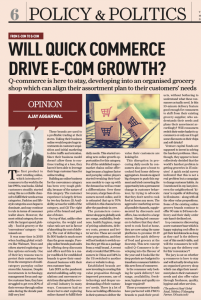Most modern retailers rely on simple logic to measure their success: if sales are up, business must be doing well. What they don’t consider is, you don’t have to do much to grow in India today.
Modern retail accounts for 4-5% of overall trade while the number of consumers who want to shop in this format is much larger. So, a new store in a suitable catchment always does well as consumers accept new shopping opportunities. This trend will continue until the modern retail share exceeds 20% of overall retail.
But modern retailers may be reducing their profits by spending more than what is required on marketing and customer acquisition. The focus is not on retaining existing customers by improving their shopping experience and using these customers for the free word-of-mouth publicity. Modern retailers believe they are providing good shopping experiences because the number of customer complaints is low (or none).

Fact is, most unhappy customers don’t complain. Most of them just give up on that retail outlet and find another one. But achieving customer satisfaction is not that difficult. All that modern retailers need to do is change a few policies and processes.
The best retail lessons I have learned come from spending a few hours each week in various stores. I also make it a point to visit new stores in my city to explore new practices and issues.
The other day, I attended the opening of a hypermarket and was appalled to find that only nine out of 21 check-out stations were operational. Customers were in queue with their trolleys feeling frustrated. Surprisingly, the store manager didn’t seem to be worried at all. He said most cashiers have been rostered for the evening shift. And this was at the opening!
A long wait at the check-out is one of the main reasons of customer dissatisfaction. To avoid the queue, several people might actually avoid shopping there. A simple change of store policy here might retain these customers and even get new ones.
Customers also get highly disappointed when advertised items are out of stock. They feel that the advertisement was just a bait to bring them to the store where they will be pressured (through subtle manipulation via the floor-plan, billboards, flyers, offers, panel colours, background music) to buy something else.
Customers also get affected when items they regularly purchase are often not available. Such customers are less likely to return and definitely won’t recommend that store to their friends.
Smart retailers understand that the cost of inventory is measured not only against the loss of one sale, but against future purchases as well. I believe at least two-thirds of any brand’s customers are willing to pay more for high quality experience and service.
Price is not always the key driver for higher sales. While no brand can provide a problem-free shopping experience, their ability to solve customer problems quickly is what the customer values and is willing to pay extra for.
I’ve observed that almost all customers who come to return a purchased item are honest but the process requirements don’t always treat them so and they end up quite frustrated. If store employees are encouraged to view each transaction as an opportunity to drive customers away or retain them, if the customer admits to having lost the receipt and seems honest, the staff should be encouraged to “break the rules” and process the return.
Policies and processes like these can cause serious damage to customer retention. Most of the time, both customers and staff don’t complain because they assume policies are unchangeable. With a little effort, modern retailers can encourage feedback from both. And by improving their customer experience, they will drastically improve their bottom line.
From a series of articles commissioned by DNA (Money) dated 4 January 2012.



